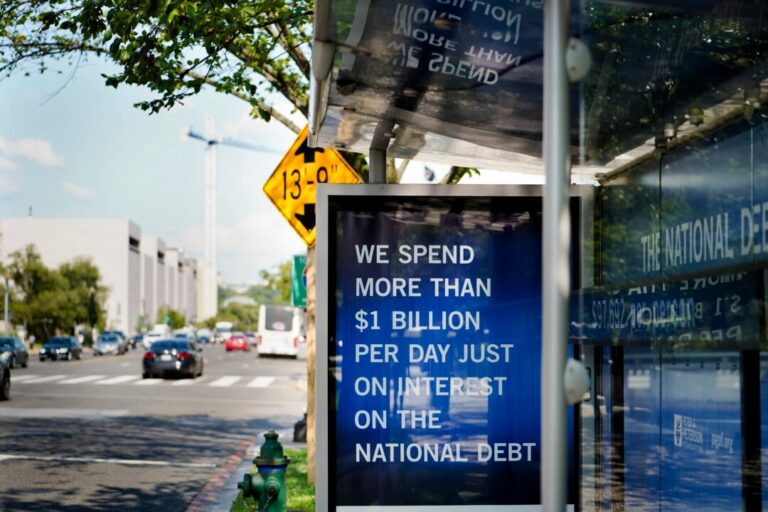Photo: The National Debt Clock is seen at a bus stop in Washington on July 31, 2023. (Madalina Vasiliu/The Epoch Times)
Current debt levels are equal to $105,000 per person and $266,000 per U.S. household.
Washington accumulated another $1 trillion in debt in less than seven months. Over the past 12 months, the national debt has spiked by nearly $2.35 trillion, an average of about $6.4 billion per day.
Since January 2021, the national debt has increased by about $7.3 trillion.
The immense growth of red ink flooding the nation’s capital has captured the attention of public policymakers.
In a February interview on “60 Minutes,” Federal Reserve Chair Jerome Powell conceded that the federal government is “on an unsustainable fiscal path.”
“And that just means that the debt is growing faster than the economy. So, it is unsustainable. I don’t think that’s at all controversial,” Mr. Powell said.
Two of the big three credit agencies—Moody’s Investors Service and Fitch Ratings—downgraded their outlook on the U.S. debt, citing fiscal deterioration, persistent debt ceiling negotiations, and ballooning interest payments.
“While the statement by Moody’s maintains the United States’ AAA rating, we disagree with the shift to a negative outlook. The American economy remains strong, and Treasury securities are the world’s preeminent safe and liquid asset,” Deputy Treasury Secretary Wally Adeyemo said in a statement.
In recent months, Treasury Secretary Janet Yellen has offered mixed assessments of the country’s fiscal situation.
GDP and Interest Payments
The national debt is measured in current dollars, meaning that it is not adjusted for inflation. Therefore, to properly compare the debt with the economy, officials also gauge the economy in current dollars.
The current-dollar GDP has increased by more than 30 percent since the onset of the COVID-19 pandemic. By comparison, the national debt rocketed by about 50 percent in the same span.
Interest payments have climbed significantly since the Federal Reserve began its quantitative tightening cycle in March 2022 (a blend of higher interest rates and balance sheet tapering).
Net interest payments totaled $682 billion in the first nine months of the fiscal year, while defense payments were $644 billion.
The meteoric ascent of interest charges has been eating up a substantial portion of federal revenues.
In June, interest payments ($140 billion) consumed three-quarters of the month’s individual income tax revenue ($184 billion).
Budget Deficit
In June, the Congressional Budget Office (CBO), a nonpartisan budget watchdog, updated its outlook for the rest of the fiscal year and the next decade.
Officials adjusted their forecast for this year’s budget deficit by $400 billion, or 27 percent, to $1.9 trillion from $1.5 trillion.
Ten-year baseline projections also highlighted that debt held by the public will exceed $50 trillion by 2034, swallowing the entire U.S. economy’s output.
“Relative to the size of the economy, debt swells from 2024 to 2034 as increases in interest costs and mandatory spending outpace decreases in discretionary spending and growth in revenues,” the CBO stated. “Debt held by the public rises from 99 percent of GDP this year to 122 percent in 2034, surpassing its previous high of 106 percent of GDP.”
Cumulatively, from 2025 to 2034, the annual federal deficit will total $22 trillion, and interest payments will be close to $13 trillion.
This includes $85 trillion in federal spending, fueled by $51.4 trillion in mandatory outlays, $20.5 trillion in discretionary, and the rest in net interest.
The Epoch Times reached out to members of the House Budget Committee for comment.
How useful was this article ?
Click on a star to rate it!
Average rating 0 / 5. Vote count: 0
No votes so far! Be the first to rate this post.
We are sorry that this post was not too useful for you!
Let us improve this post!
Tell us how we can improve this post?
















1 thought on “US National Debt Hits $35 Trillion Milestone – The Epoch Times”
Without real growth (GDP) beyond the rate of inflation; we are going backwards or in other words we are NOT growing the economy. Cutting spending and restoring-increasing all fossil fuel production will spur lower costs in most all products but a Trump-Vance administration is required. New tariffs and bringing manufacturing back to America will multiply the dollars times five as those NEW dollars are re-spent in each town where located. These measures will reduce interest rates spurring home and vehicle sales for even more taxes for the treasury. A win-win if we elect Trump-Vance Nov.5th
Comments are closed.